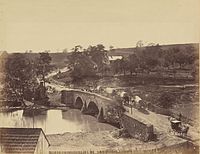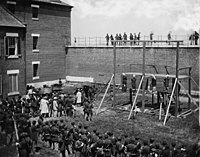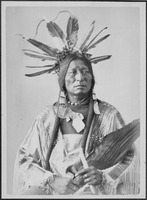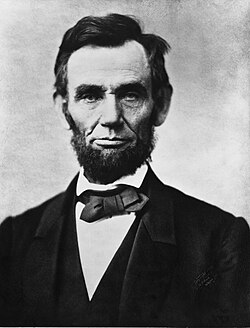Alexandr Gardner
| Alexandr Gardner | |
|---|---|
 | |
| Narození | 17. října 1821 Paisley |
| Úmrtí | 10. prosince 1882 (ve věku 61 let) Washington, D.C. |
| Místo pohřbení | Glenwoodský hřbitov |
| Povolání | fotograf a válečný fotograf |
| Příbuzní | James Gardner[1] (sourozenec) |
| Některá data mohou pocházet z datové položky. | |
Alexander Gardner (17. října, 1821 – 10. prosince, 1882) byl skotský a americký fotograf. Je známý především svými dokumentárními snímky z Americké občanské války a portréty amerického prezidenta Abrahama Lincolna.
Život a dílo

Gardner fotografoval většinou krátce po skončení bitev. Nevyhýbal se ani detailním pohledům na mrtvé. Ukázalo se však, že nejméně jedna jeho fotografie je zmanipulovaná. V roce 1961 Frederic Ray z magazínu Civil War Times srovnával několik Gardnerových fotografií, na kterých byli dva mrtví konfederační ostřelovači a zjistil, že stejný subjekt byl fotografován na různých místech. Zdá se, že Gardner nebyl spokojen s kompozicí, nechal těla různě zpřeházet a vytvářel si tak vlastní verzi reality. Rayovu analýzu ještě rozšířil v roce 1975 William Frassanito.[2]
Abraham Lincoln se stal americkým prezidentem v listopadových volbách 1860 a spolu s jeho jmenováním přišla hrozba války. Gardner měl ve Washingtonu velmi dobrou pozici a cit pro velké věci. Jeho popularita začala vzrůstat portrétováním vojáků odcházejících do války. Napadla jej myšlenka fotografovat občanskou válku.
Nejznámější jsou Gardnerovy reportážní snímky z pohřbu Abrahama Lincolna a seriál z popravy atentátníků. Patrně poprvé v dějinách fotografie bylo v jeho reportáži využito dramatického účinku střídání celkových záběrů a detailů v delším časovém úseku, neboť Gardner zachytil nejen průběh popravy, ale i tváře atentátníků.[3]
Mathew Brady, který zůstával většinou ve Washingtonu, D. C., kde organizoval své asistenty a zřídka navštívil bitevní pole osobně, zaměstnával několik fotografů, kromě Alexandera Gardnera také Jamese Gardnera, Timothyho O'Sullivana, Williama Pywella, George N. Barnarda a dalších osmnáct mužů, kteří byli ochotni kdykoliv vyjít ven do rozpoutané války a fotografovat scény z americké občanské války. Jejich snímky byly součástí knihy Photographic Sketch Book of the War svazek 1 a 2 (Washington, DC. Philp & Solomons), kterou Gardner vydal v roce 1866. William Pywell jej doprovázel také při expedici do Kansasu.[4]
Galerie
Tzv. Gettysburg Portrait, portrétní fotografie Abrahama Lincolna pořízená 8. listopadu 1863
Most přes potok Antietam, září 1862
Abraham Lincoln, Allan Pinkerton a John Alexander McClernand v bitvě u Antietam, 1862
Poslední spánek ostřelovače: Bitva u Gettysburgu, 1863
Exekuce konspirátorů: Mary Surratt, Lewis Powell, David Herold a George Atzerodt – Lincolnův vrah; 7. července 1865
Detail tváře Lewise Powella, zatčeného spiklence po vraždě, 1865
Detail tváře Davida Herolda, zatčeného konspirátora po vraždě, 1865
Many Horns-Hatona. Tachana, Sioux, ze série portrétů Tribalské delegace Federální vlády, 1872
Odkazy
Reference
V tomto článku byl použit překlad textu z článku Alexander Gardner (photographer) na anglické Wikipedii.
- ↑ Union List of Artist Names. 2. března 2019. Dostupné online. [cit. 2021-05-21]
- ↑ LEGGAT, Robert. GARDNER, Alexander [online]. http://www.rleggat.com, 2008-09-23 [cit. 2009-02-19]. Dostupné online. (anglicky)
- ↑ SIMKIN, John. USACW paine [online]. http://www.rleggat.com [cit. 2009-02-19]. Dostupné v archivu pořízeném dne 2009-01-07. (anglicky)
- ↑ Spartacus Educational. www.spartacus.schoolnet.co.uk [online]. [cit. 23-11-2010]. Dostupné v archivu pořízeném dne 11-01-2008.
Literatura
- Indiana Historical Society. Alexander Gardner: Biographical Sketch [online]. William Henry Smith Memorial Library [cit. 2006-08-04]. Dostupné online.
- Gardner, Alexander. Gardner's Photographic Sketch Book of the Civil War. New York: Dover Publications, 1865-1866, Reprinted 1959. Dostupné online. online version images
- Katz, Mark D. Witness to an Era: The Life and Photographs of Alexander Gardner. New York: Viking Studio Books, 1990. Dostupné online.
Externí odkazy
 Obrázky, zvuky či videa k tématu Alexandr Gardner na Wikimedia Commons
Obrázky, zvuky či videa k tématu Alexandr Gardner na Wikimedia Commons - A Eulogy on the Life and Character of Alexander Gardner at the Library of Congress
- Alexander Gardner [online]. Spartacus Educational [cit. 2008-10-25]. Dostupné v archivu pořízeném dne 2010-02-09.
- Photojournalism: An Ethical Approach includes a passage on Gardner
- Museum-quality prints of Alexander Gardner photographs Archivováno 22. 7. 2009 na Wayback Machine. by Argent Editions
Média použitá na této stránce
Lewis Powell (AKA Lewis Payne) at the Washington Navy Yard, District of Columbia. Powell, wearing an issued navy shirt, is seated and manacled aboard a prison barge. Powell attempted to assassinate U.S. Secretary of State William Seward on April 14, 1865.
Burnside's Bridge (Antietam Bridge), near Antietam, Maryland, in autumn 1862.
- Site of the 'afternoon battle' of the Sept. 1862 Battle of Antietam.
- The caption on the original says "ALEX. GARDNER, Photographer, Entered according to act of Congress, in the year 1866, by A. Gardner, in the Clerk's Office of the District Court of the District of Columbia. 511 Seventh Street, Washington."
- The previous page says:
- "Antietam Bridge, Maryland."
- "This structure crosses Antietam Creek on the turnpike leading from Boonesboro to Sharpsburg, and is one of the memorable spots in the history of the war, although but little suggestive in its present sunny repose, of the strife which took place near it, on the day of the battle of Antietam. Traces of the engagement are evident in the overturned stone wall, the shattered fences, and down-trodden appearance of the adjacent ground. On the night of the 16th of September, the cavalry of the Army of the Potomac captured this bridge after a sharp fight, holding it until the infantry came up. The fire of our artillery, planted on the ridges near the bridge, was terrible, and at one time no doubt contributed principally to the success of our partially disordered lines in checking the headlong assaults of the enemy."
- "After Lee's second invasion of Maryland, which ended with the battle of Gettysburg, and the escape of his army into Virginia at Williamsport and Falling Waters, Gen. Meade had his headquarters for a number of days on a wooded ridge called the “Devil's Backbone,” situated near this stream, along which the Army of the Potomac was encamped. Very little now remains to mark the adjacent fields as a battle ground. Houses and fences have been repaired, harvests have ripened over the breasts of the fallen, and the ploughshare only now and then turns up a shot, as a relic of that great struggle."
Alexander Gardner, self-portrait. The Scottish-born photographer Alexander Gardner (1821-1882) was appointed a staff photographer under General George B. McClellan. He became famous for his Civil War-era images, including the aftermath of the Battle of Antietam. Image credit: Library of Congress.
Execution of the four people condemned as conspirators (Mary E. Surratt, Lewis T. Powell, David E. Herold, and George A. Atzerodt)
Allan Pinkerton, President Abraham Lincoln, and Major General John A. McClernand. This photo was taken not long after the Civil War’s first battle on northern soil in Antietam, Maryland on October 3, 1862. Pinkerton was the head of Union Intelligence Services at the time. He also, allegedly, foiled an assassination attempt against Lincoln. His wartime work was critical in Pinkerton’s development, which he later used to pioneer the American private detective industry when he formed the Pinkerton National Detective Agency.
David E. Herold, one of the conspirators in the assassination of Abraham Lincoln, photographed in the Washington Navy Yards, Washington D.C., after his arrest. Retouched to clean up dust and scratches. Cropped from the original in the Library of Congress archives.
Abraham Lincoln, head-and-shoulders portrait, traditionally called "last photograph of Lincoln from life"
Abraham Lincoln, the sixteenth President of the United States.

















